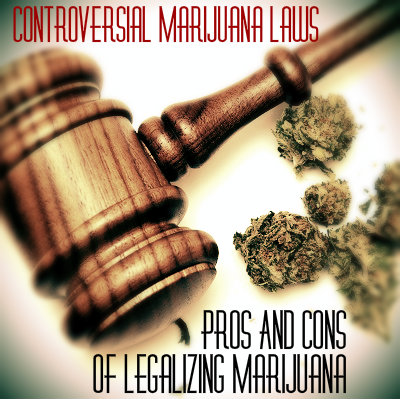08 Oct 2014
Controversial Marijuana Laws
Americans have long debated legal recreational marijuana pros and cons, as well as the positives and negatives of medical marijuana. Never has the debate been more heated than now, when controversial laws have been passed in a number of states. More than 20 states have passed laws legalizing medical marijuana, or cannabis, while two states now allow legal recreational use of the drug.
Pros And Cons Of Legalizing Marijuana
Many people can see both sides of the issue, but it remains one that is highly controversial.
The Pros Of Recreational Marijuana
Last year, two states voted to legalize recreational marijuana: Washington and Colorado. More people in these states supported the legalization than were against it, and yet it remains highly controversial. Supporters of recreational cannabis being legal have several reasons they see the recent laws as positive.
Perhaps the biggest reason is that the states will have a new source of tax revenue. The idea is that state governments, many of which have big fiscal deficits, can regulate and heavily tax the legal pot sales. Other reasons supporters cite for legalizing the drug include greater freedoms for law-abiding citizens and a more modern attitude toward pot.
The Cons Of Decriminalizing Cannabis
Not everything about making marijuana legal for recreational use is positive. Critics have plenty to say about the new laws, probably more than the supporters. Legal marijuana poses a number of issues. The first is safety for individuals. Marijuana is a drug; it causes side effects and impairs judgment. It is also addictive and can lead to a lifelong dependence, especially with frequent use.
Legal marijuana is also a problem of public health. While individuals may now have the right to choose to use the drug, the rest of us are not able to choose not to be impacted. The most obvious risk is the possibility of impaired driving. Drunk drivers cause thousands of accidents, injuries and deaths every year. High drivers stand to cause even more.
Finally, there is the issue of the impact of legal marijuana on young people. Of all the cons for legalizing marijuana, this may be the most troubling. Although its use is to be restricted to adults, legal marijuana means that young people will inevitably have greater access to the drug. Currently, alcohol is the substance most abused by teens. This can be attributed to its legal status and ready availability. If every state legalizes pot, you can expect teens will get access to marijuana as well. The drug can cause long-term problems in young users including impaired memory and cognitive functioning.
Legalized marijuana will likely remain a controversial topic of debate throughout the country. Although two states have allowed recreational use of the drug for adults, the possible negative consequences of these moves are great. Exactly how the drug will start to effect young people and public health remains to be seen.
26 Aug 2014
How Changing Marijuana Laws May Impact Children
Changing attitudes toward marijuana in society have led directly to voters changing laws in municipalities and across entire states. Nearly half of all states allow the use of marijuana for medical purposes and two allow adults to use it recreationally, even while the federal government still outlaws the drug entirely. Many people see the benefits of allowing more use of the drug (e.g., helping people with certain medical issues and increasing state revenues). Others are more worried about the unforeseen consequences, such as how greater access to marijuana will affect children.
Kids Mimic Adult Attitudes Toward Marijuana
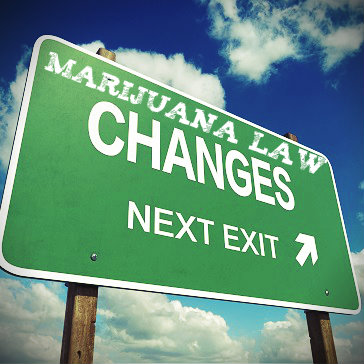 The changes in laws regarding the use of marijuana run parallel to the shift in the public’s general attitude toward this drug. Many supporters of marijuana legalization cite statistics and research that show how much safer the drug is than alcohol, a legal substance. Legalizing marijuana could make this less harmful substance as acceptable as alcohol. Many people see this as positive because it would provide tax revenue for state governments.
The changes in laws regarding the use of marijuana run parallel to the shift in the public’s general attitude toward this drug. Many supporters of marijuana legalization cite statistics and research that show how much safer the drug is than alcohol, a legal substance. Legalizing marijuana could make this less harmful substance as acceptable as alcohol. Many people see this as positive because it would provide tax revenue for state governments.
When you consider how children absorb the attitudes of the adults around them, you can understand how destructive legalized marijuana could be for young people. Most would agree that children and teens shouldn’t be allowed access to marijuana, but by sensing the lax attitude toward the drug that many adults have, young people will not take the risks of using marijuana seriously.
Alcohol, for instance, is legal for adults and considered to be socially acceptable among most people. As a result, teens use it too. Nearly half of all high school students drink, despite the negative consequences the behavior could produce. As adult attitudes toward marijuana shift to include social acceptance, you can expect teens to follow suit and begin to use the drug more often. As with alcohol, smoking marijuana is bad for teens. It affects the still-developing brain and can cause mental health issues as well as addiction.
Kids Poisoned By Marijuana
Laws giving adults greater access to marijuana mean children come into contact with the drug more than ever before. Because of this there has already been an increase in accidental ingestion by kids. Researchers found that there was a spike in visits to emergency rooms after states legalized medical marijuana and the federal government stated that it would not prosecute anyone with respect to its use for medical purposes.
One of the most common ways in which kids accidentally take in marijuana is through foods and drinks containing the drug. Such ingestions can cause children to have hallucinations, to have difficulty breathing, to lose consciousness, and even to die if the amounts are high enough or if the child isn’t treated immediately. What might be most worrisome about accidental poisonings of kids by marijuana is that it is a new phenomenon and doctors are not yet aware of all the possible harm it can cause.
Parental Neglect
Another way in which legalized marijuana, particularly for recreational use, may impact children is how parents getting high will treat their kids. Everyone knows how disruptive, and even abusive, an alcoholic parent can be to children, but what about a parent who gets hooked on using marijuana? Maybe the results would not be as devastating, but a parent who is high is not likely to do his or her job very well. Only time will tell if we see more neglect of children as marijuana use becomes legal.
Whenever laws change with respect to drugs or alcohol it is important to consider how the changes will affect young people. No matter how thoughtfully laws are crafted, or how careful adults and dispensaries are with the drug, children are bound to be impacted by increased access to marijuana.
Check Out More News On Drugs And Addiction
31 Jul 2014
The Downside Of Legalizing Marijuana
When examining the issue of marijuana legalization, pros and cons fill up both sides of the balance sheet. But while there may be some benefits to legalization, it should be noted that benefits of pot legalization do not directly translate to benefits of pot use. While the downsides and dangers of pot use are plentiful, that is a separate issue.
Marijuana – Not Harmless Or Equivalent To Medicine
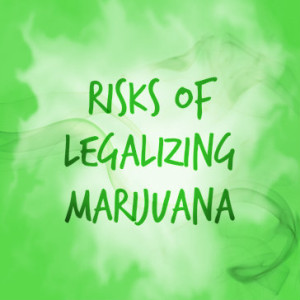 One of the primary cons of marijuana legalization is the mixed message it sends to users and potential users, especially teens. Proponents of marijuana legalization speak of health benefits or cite it as a treatment for chronic pain or for the relief of symptoms associated with chronic illnesses such as cancer, multiple sclerosis and even AIDS. This language takes marijuana out of the realm of “illicit drug” and into the category of “alternative medicine.” If not seen as a substance that promotes health, it will, at least be seen as harmless. Unfortunately marijuana is not harmless, nor is it akin to medicine.
One of the primary cons of marijuana legalization is the mixed message it sends to users and potential users, especially teens. Proponents of marijuana legalization speak of health benefits or cite it as a treatment for chronic pain or for the relief of symptoms associated with chronic illnesses such as cancer, multiple sclerosis and even AIDS. This language takes marijuana out of the realm of “illicit drug” and into the category of “alternative medicine.” If not seen as a substance that promotes health, it will, at least be seen as harmless. Unfortunately marijuana is not harmless, nor is it akin to medicine.
Though marijuana has been legalized in some states for medical use, that does not mean it has been approved by the FDA as a treatment for any sort of medical condition. Nor should it be linked with other non-FDA approved treatments and therapies such as herbal remedies, alternative medicines or vitamins. Regardless of its legal status, marijuana is a drug and it carries with it health risks and consequences. And voting to legalize it actually undermines the authority of the FDA, putting the task of approving drugs and medical treatments into the hands of voters and legislators.
High Risk For Dependence And Health Consequences
Questionable health benefits notwithstanding, people who use marijuana for medical or recreational purposes are building a relationship with a substance that carries a high risk of dependence and addiction. Using marijuana “medically” does not mean that one is exempt from short-term memory loss, that cognitive function is not impaired, that lung tissue is not damaged or that it may not become a gateway drug to more potent and dangerous substances.
Risks Outweigh Suggested “Benefits”
Those who oppose legalization continue to argue that any suggested benefits of marijuana use are far overshadowed by the risks and dangers. Anti-legalization doctors and scientists demonstrate that there are no measurable health benefits of marijuana use. The scientific research does not support the claims and adequate, reliable research has not been conducted. The conditions for which medical marijuana may be useful are broad and vague. Opponents also note that the legal, non-marijuana therapies currently on the market are more effective in treating the conditions for which pot is suggested
The cons of legalizing marijuana are many. Though marijuana may have some suggested (though not scientifically proven) health benefits, it is important to remember that those benefits come with risk as well. Legalization of marijuana not only sends the wrong message to young people about what is medicine and what isn’t, what is healthy and acceptable for use and what isn’t, it also may open the door to increased legalization of pot for recreational use. This in turn may lead to the demand for more hardcore illicit drugs, not to mention an increase in the national addiction epidemic.
Learn More About Drug Rehab Addiction News And Laws
01 Jul 2014
How Have Marijuana Laws Changed?
Attitudes toward cannabis, also known as marijuana, have been undergoing a major shift in recent years. Long known to be one of the less hazardous of illicit drugs, smoking pot still carries risks. There are health problems, the possibility of harming children and teens, not to mention the dangers of driving while high. In spite of the negative aspects, some believe in the pros of legalizing marijuana for recreational use, including voters in Colorado and Washington state.
Which Marijuana Policies Have Changed?
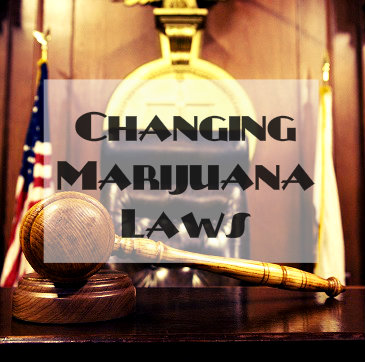 Society’s attitudes toward marijuana have been changing for decades. Some municipalities decriminalized the possession of small amounts of marijuana long ago. In these cities, users may get ticketed, but fines and other repercussions are minimal. In 1996, California became the first state to pass and enact legislation for the legalization of medical cannabis. This allowed doctors to prescribe marijuana to patients who might see benefits from using it.
Society’s attitudes toward marijuana have been changing for decades. Some municipalities decriminalized the possession of small amounts of marijuana long ago. In these cities, users may get ticketed, but fines and other repercussions are minimal. In 1996, California became the first state to pass and enact legislation for the legalization of medical cannabis. This allowed doctors to prescribe marijuana to patients who might see benefits from using it.
After debating the pros and cons of legalizing cannabis, 20 states, as well as the District of Columbia, now allow the legal use of medical marijuana. More recently, residents in the states of Washington and Colorado voted to expand the legality of cannabis and recreational use is now allowed. Alaska may be the next state to pass such legislation. Enough signatures have been collected there to get the issue on the ballot this summer. While states continue to make policy changes regarding marijuana, it is important to remember that this is still an illegal drug, for any type of use, according to the federal government.
What Are The Cons Of Legalizing Marijuana?
Perhaps the biggest reason that states have agreed with their voters and have decided to start legalizing marijuana is for the revenue. As state and local budgets suffer, taxes collected from selling marijuana could make a big difference. There are downsides too, which states and local governments need to consider. The most obvious negative impact could be public health. Marijuana is a mind-altering substance that is most often smoked and could contribute to cancer and lung disorders.
Cannabis is a drug with psychoactive properties. It renders users relaxed and happy, but can also cause paranoia, delusions, and, as a result, some risky behaviors. It impairs judgment and can cause the user to make bad choices and can lead to self-harm and accidents. Just how damaging users under the influence may be remains to be seen. Driving while high on legal marijuana could be a huge issue for public safety.
Among all the negatives of legalizing marijuana, some critics are most concerned about how the policy changes could affect young people. Alcohol has long been legal, but controlled and age-restricted, and yet the harm that it has caused to teens has been dramatic. Underage drinking kills many people every year. Critics of legalized cannabis worry that marijuana will get into the hands of kids and teens more often now and that the impact could be severe. As policies and attitudes regarding this drug shift across the country, it is our responsibility as citizens to be informed.
06 Jun 2014
Online Drug Trafficking Becoming Alarming
A recent survey found that there has been an increase in drugs being sold on the Internet, and the results indicate a rise in global drug use in general.
According to the Global Drugs Survey, 60 percent of respondents reported buying illegal drugs like marijuana and LSD online.
Main Reasons For Online Drug Trafficking Increase
 What’s causing this increase in online drug trafficking? The main reason is sites that allow people to anonymously buy drugs using bitcoin peer-to-peer digital currency. The most famous online drug source was the original Silk Road online market, which was shut down by the Federal Bureau of Investigations in October, 2013. Drug officials also report the increase of online trafficking is because users often face the chance of being robbed or physically assaulted during face-to-face drug exchanges, so they feel that online transactions are safer.
What’s causing this increase in online drug trafficking? The main reason is sites that allow people to anonymously buy drugs using bitcoin peer-to-peer digital currency. The most famous online drug source was the original Silk Road online market, which was shut down by the Federal Bureau of Investigations in October, 2013. Drug officials also report the increase of online trafficking is because users often face the chance of being robbed or physically assaulted during face-to-face drug exchanges, so they feel that online transactions are safer.
Respondents to the Global Drug Survey reported that, just like overall Internet shopping, buying drugs online is faster, cheaper and there is a larger selection. The survey found that over 40 percent of participants said they were buying online for the first time, which proves that the web is a growing resource for drug users.
The overall cause of the increase in online drug purchases can be explained by the increase in drug use overall. The survey found that a third of the respondents between the ages of 18 and 24 used drugs, which had increased from a previous survey showing only a fifth of that amount. The Global Drug Survey collected data from 45 countries and 80,000 individuals.
Marijuana is the drug of choice in many countries. Brazil, France and the United States are countries with the highest rate of marijuana consumption. The survey found that 70 percent of Brazilian and American respondents used marijuana.
Another cause for the increase in global drug use can also be blamed on the legalization of marijuana. Countries around the world seem to have conflicting opinions on legalization. The United Nations reportedly feels that legalization poses a great danger to its country. However, Uruguay legalized the drug’s sale and production last year. In the United States, Colorado and Washington State were the first states to legalize the use of the drug recreationally, though with many limitations. In the Netherlands, possession of marijuana under five grams has been legal since 1976.
Something alarming that the survey found that was only about 20 percent of those 80,000 respondents reported ever seeking help or having feelings that marijuana use had a negative effect on their job or schooling.
Read More About How The War On Drugs Isn’t Effective At Protecting Youth
05 Jun 2014
How Can Marijuana Use Lead To Heart Disease?
The use of cannabis (marijuana, hashish and hashish oil) is linked to a range of potential health problems, including diagnosable abuse and/or addiction and increased odds of experiencing some of the psychosis-related symptoms associated with schizophrenia and certain other severe mental illnesses.
In a study published in April 2014 in the Journal of the American Heart Association, a team of French researchers investigated another possible consequence of cannabis use: dysfunction in the cardiovascular (heart and blood vessel) system. These researchers concluded that young adult cannabis users, in particular, put themselves at increased risk for potentially life-threatening cardiovascular problems.
Marijuana Use Stats
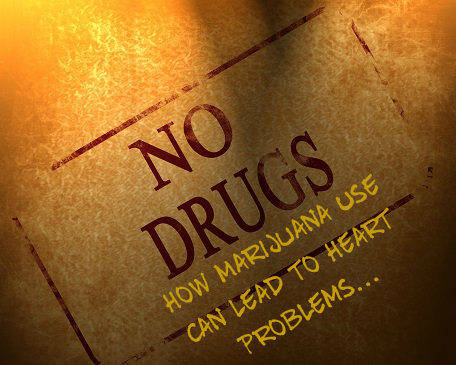 Cannabis use (particularly, marijuana use) is a relatively common form of recreational substance intake among U.S. adults and teenagers, according to figures compiled by the federal Substance Abuse and Mental Health Services Administration. In 2012 (the last year with fully available statistics), almost 19 million Americans over the age of 11 used marijuana in a given month; this number is the equivalent of more than 7 percent of the teen and adult population.
Cannabis use (particularly, marijuana use) is a relatively common form of recreational substance intake among U.S. adults and teenagers, according to figures compiled by the federal Substance Abuse and Mental Health Services Administration. In 2012 (the last year with fully available statistics), almost 19 million Americans over the age of 11 used marijuana in a given month; this number is the equivalent of more than 7 percent of the teen and adult population.
The highest rates of intake for marijuana and all other illegal or misused substances occur in teenagers and young adults between the ages of 16 and 34. Within this fairly broad age range, peak rates of use occur among individuals in their late teens or early 20s. Intake rates are lowest among very young adolescents and adults age 60 or older. Throughout the U.S., only alcohol and nicotine outrank marijuana as popular substances of abuse.
Cardiovascular Risks Associated With Marijuana Use
One of the most serious cardiovascular problems is acute coronary syndrome, a term that doctors use collectively to describe any condition that produces a rapid decrease in blood supplied to the tissues that make up the heart muscle. Well-known conditions that meet this definition include heart attack (loss of blood flow and tissue death in specific areas of the heart) and cardiac arrest (stoppage of all heart function). Acute coronary syndrome also includes a form of unpredictable chest pain called unstable angina.
In the study published in the Journal of the American Heart Association, researchers from four French institutions used information from an ongoing project called the French Addictovigilance Network to assess the cardiovascular risks faced by people who use marijuana or other forms of cannabis.
In France, this network acts as a national reporting system for all people seriously impacted by any type of substance abuse or substance addiction. The researchers looked at data gathered from 2006 to 2010. All told, 1,979 reports of serious cannabis-related harm were registered with the Addictovigilance Network during this timeframe.
The researchers found that cardiovascular problems accounted for just 1.8 percent of all cannabis-related harm. However, they also found that many of the reported cardiovascular problems were severe or potentially lethal in nature. For example, over half of the affected individuals suffered from acute coronary syndrome.
Other reported problems included complications related to the function of blood vessels located in the upper or lower limbs, as well as complications related to the function of blood vessels inside the brain. Altogether, fully 25.6 percent of the cannabis users impacted by serious cardiovascular issues died as a result of their condition.
Does Marijuana’s Negative Cardiovascular Effects Have A Greater Impact In Men?
The authors of the study published in the Journal of the American Heart Association found that the vast majority (85.7 percent) of the cannabis users affected by serious cardiovascular problems were male. On average, affected individuals of both genders were just over the age of 34. The study’s authors specifically note that young adults who use cannabis may have increased risks for potentially fatal cardiovascular issues.
In line with this conclusion, they call for wide distribution of information regarding the link between cannabis use and serious heart- and blood vessel-related harm. In addition, they call upon doctors to consider cannabis intake as a possible source or contributing factor for any cardiovascular problems found in young adult patients.
Find Out If Marijuana Is Really Dangerous Now!
Call Us Immediately If You Believe You Or Someone You Know Is Abusing Drugs Or Alcohol!
26 May 2014
Marijuana Habits May Dictate Dependence
If scientists can develop an understanding of how a casual user sometimes becomes an addict while others do not, they may be more equipped to prevent addiction. Understanding how casual marijuana experimentation turns into addiction may help in prevention and intervention strategies, in addition to shaping public policy. A recent study identified behavior patterns that may determine whether a person develops an addiction to marijuana.
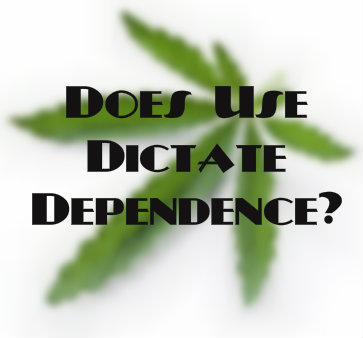 The study, which was led by Peggy van der Pol of the Trimbos Institute of the Netherlands Institute of Mental Health and Addiction, suggests that theories about whether increased levels of the psychoactive ingredient delta-9-tetrahydrocannabinol (THC) can influence addiction may not be relevant. With varying potencies of THC available in marijuana, the researchers wanted to see whether potency, habits of the user or both determined the likelihood of them becoming addicted.
The study, which was led by Peggy van der Pol of the Trimbos Institute of the Netherlands Institute of Mental Health and Addiction, suggests that theories about whether increased levels of the psychoactive ingredient delta-9-tetrahydrocannabinol (THC) can influence addiction may not be relevant. With varying potencies of THC available in marijuana, the researchers wanted to see whether potency, habits of the user or both determined the likelihood of them becoming addicted.
Some scientists have argued that even when THC is more potent users may compensate by inhaling less. However, the authors say there is a much more relevant predictor.
While smokers of more potent pot receive more THC now than users of older generations of marijuana, the style of smoking is a better predictor of which users are likely to become dependent. Van der Pol explains that while every drug carries risk, the more potent forms of marijuana cause the user to take in more THC.
How Is Dependence Developed?
Other studies have focused on frequency of use when examining how dependence developed, as well as THC levels. Van der Pol’s team looked at data from 98 young adults enrolled in a long-term study on regular marijuana use in the Netherlands. The users were recruited from cannabis dispensing coffee shops, as well as through referrals. The participants all reported using marijuana at least three days per week in the previous year. One in three of the participants met criteria for dependence at baseline. The participants were mostly men and were an average age of 23.
Eighteen months after recruitment, and at another follow-up point at three years, the participants were interviewed about their cannabis use, and were even asked to smoke during the interview.
The researchers documented the specific behaviors each participant demonstrated, from rolling their joints to how often they puffed on the joint. To provide a picture of regular behaviors, the participants were asked to bring their own cannabis and roll their own joints.
The smokers who used more potent pot containing higher concentrations of THC did not roll weaker joints. Instead, they used more pot in each joint when compared to users of less-potent marijuana.
The potent pot users did inhale less smoke and had a slower pace of smoking when compared with their peers. However, these adjustments weren’t sufficient to compensate for the higher level of THC in the marijuana.
Instead of THC exposure, the study results showed that only behaviors specific to smoking were predictors of dependence. How many puffs a smoker took, and the amount they smoked, were the only strong predictors of dependence at three years following the initial examination.
The study’s findings may have an immediate impact on how users are educated about marijuana dependence. New users may be exposed to a stronger potency of marijuana and consume high levels of THC.
Find Out If Marijuana Legalization Is Leading To Increased Use
Two trends in substance use are affecting the bottom line among small businesses. One is a significant increase in the abuse of prescription painkillers. The other is the increased use of marijuana as a result of increased deregulation.
According to a survey conducted by Employers Holdings Inc., one out of 10 small businesses report having employees show up to work while under the influence of at least one controlled substance, with lost productivity and potential insurance costs affecting the bottom line of the business.
Many companies require that employees provide a clean urine or blood sample both at hiring and at the discretion of the employer for random testing. However, in some cases, the employee may arrive at work visibly affected by a substance.
Prescription Drug Use
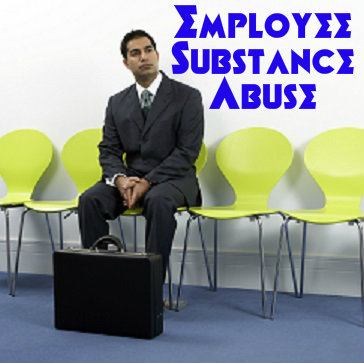 Opioid misuse has been on the rise. The U.S. Centers for Disease Control and Prevention report that more overdose deaths are now recorded for prescription opioids than for heroin or cocaine.
Opioid misuse has been on the rise. The U.S. Centers for Disease Control and Prevention report that more overdose deaths are now recorded for prescription opioids than for heroin or cocaine.
Prescription drug abuse often begins with a legitimate pain problem, often resulting from a serious injury or chronic disease. The patient may not receive adequate warnings, or they may not exercise the necessary caution in avoiding addiction to the drug.
In other cases unlocked medicine cabinets provide an opportunity for forgotten pills to be pilfered. Opioids can produce the same high as heroin, and they are a popular choice for experimentation. Many users mistakenly believe that because the drugs are obtained through a prescription from a doctor they aren’t as dangerous as street drugs.
Instead, experts say, the use of opioids can be just as dangerous as street drugs. Common reactions include a racing pulse or stroke. In some cases users may combine the drugs with other pills to make a unique cocktail and significantly increase the likelihood that they will experience negative side effects.
One potential danger of using opioids is that when a user runs out of opportunities to obtain prescription opioids from the medicine cabinets of friends and relatives the addiction may be fully developed. Buying pills on the street can be very expensive, costing $80 to $100 per pill. The remedy, in too many cases, is to start using heroin. Heroin is available and cheap, compared to prescription painkillers.
Marijuana Use Increasing
The increasing legalization of marijuana is also becoming a challenge for employers. Many don’t believe that their employees are able to work safely while under the influence, and are struggling to adequately prevent the substance from impacting their business, the safety of their employees and those they interact with on any given day.
With states beginning to allow the possession and use of marijuana, the impact is being felt by small businesses. In Colorado, where marijuana sales are booming, employers are scrambling to compensate for the impact the drug can have on their employees and their businesses.
More than half of employers surveyed even mentioned over-the-counter medications as a particular danger to employees and those around them. Three-quarters of the employers agreed that marijuana, prescription painkillers, alcohol and illicit narcotics presented a danger to their employees.
The survey was conducted by International Communications Research, who interviewed 502 small businesses that were nationally representative of small businesses that have fewer than 100 employees.
Find Out If Some Businesses Reward Drug Abuse


